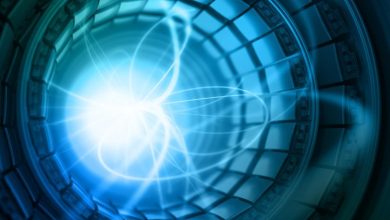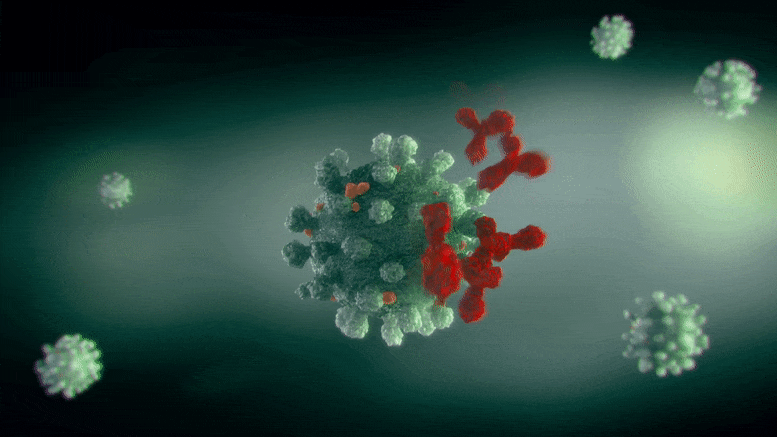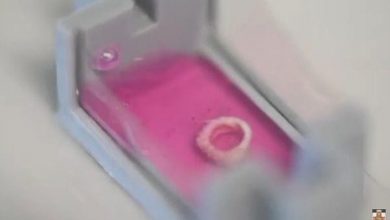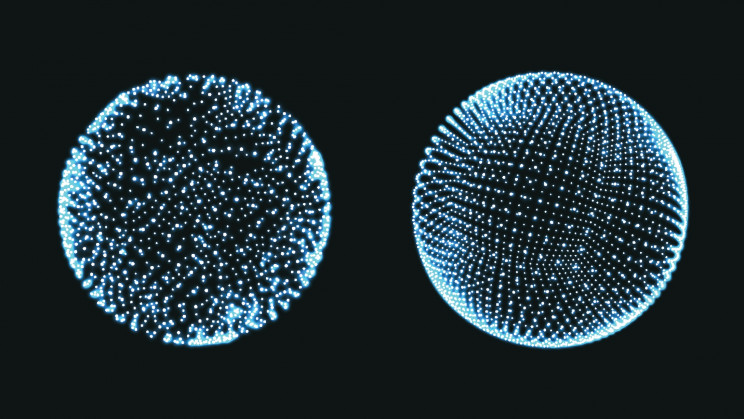
Lead Image: A team led by physicists from Oxford University analyzed data from the Large Hadron Collider (LHC) and discovered that a subatomic particle can switch between matter and antimatter, a report by New Atlas explained. Antimatter, which is differentiated by having the opposite charge to normal matter, is composed of the antiparticles of normal matter. Some particles oscillate between being matter and antimatter via superposition, as illustrated by the thought experiment of Schrödinger’s cat. In a world-first discovery, it was found that the charm meson, a subatomic particle made out of a charm quark and an antiquark, can travel as a mixture of their particle and antiparticle states, all the while spontaneously switching between the two. The finding is detailed on the preprint server arXiv. The new discovery was made thanks to stupefyingly precise measurements made by CERN’s Large Hadron Collider – both states were differentiated by a minuscule difference in mass of just 0.00000000000000000000000000000000000001 grams.
If you’re a fan of Star Trek or some other sci-fi universe, you’ve almost certainly heard of antimatter, the incredibly volatile and energetic opposite of normal matter fabled for its capability of driving warp engines or blowing up spaceships with a single well-placed torpedo. But what is antimatter, really?
Rest assured, it is a very real thing, even if there’s not a whole lot of it lying around, which is probably for the best, all things considered. And far from being exclusively the stuff of science fiction, it has important scientific and industrial applications that could prove to be rather revolutionary if they were ever able to scale economically.
That last bit is the real challenge, obviously, but it’s helped drive new innovations with antimatter that could help power warping drives sooner than you’d think.
What is antimatter?
In simple physical terms, antimatter is the mirror image of ordinary matter, but with the opposite electrical charge. So, whereas an electron is a negatively charged particle with a quantifiable atomic mass, a positron is a positively charged particle with the same atomic mass as an electron.
Both matter and antimatter can be defined by their baryon or lepton numbers. Wherever ordinary matter will have positive baryon or lepton numbers, antimatter will have negative baryon and lepton numbers.
Every particle of matter in physics is known or hypothesized to have an antiparticle equivalent, even photons. The various quarks make up the matter as we know it and thus have complementary antiquarks. These combine to form positrons, antiprotons, and antineutrons, which is mostly what we are concerned with when we commonly talk about antimatter.
There are also more elementary antiparticles like antineutrinos, while some particles are their own antiparticle (typically elementary bosons like photons or the hypothetical graviton), that do not interact with each other but simply pass through one another.
In the case of neutral composite antiparticles like the antineutron, the net charge and mass will be the same as its ordinary matter counterpart, but these are still composite particles made up of antiquark complements to the ordinary neutron’s quarks.
So rather than one up quark and two down quarks as in an ordinary neutron, antineutrons will instead be made out of an up antiquark and two down antiquarks, which is an important difference between these and something like a photon.
Since antimatter particles themselves are essentially identical to regular particles with the main difference being the reversal of their charge, antiparticles interact with each other in very familiar patterns.
Two up antiquarks and one down antiquark can combine to form an antiproton with a negative charge in the exact same way that two up quarks and one down quark form a regular proton. From there, positrons, antiprotons, and antineutrons can be captured by the same electromagnetism that pairs electrons, neutrons, and protons together to form atoms, creating an antiatom.
In both theory and practice, there’s nothing stopping the entire periodic table from having an entire complementary table full of anti elements like antihydrogen, antihelium, and antioxygen. This should extend all the way up through anti-iron, antigold, and even anti-uranium, all of which should be able to form anti compounds, like antiwater, antiquartz, and even anti-proteins.
The theory part is much easier, however, as antimatter proves incredibly difficult and costly to both produce and then contain in practice. To date, only a limited number of antihydrogen atoms have ever been created, and researchers have only gotten as far up the periodic table of anti-elements as an antihelium nucleus.
What happens when matter and antimatter come into contact?
If you know anything about antimatter, it is probably that it really does not play nice with ordinary matter.
Whenever most particles and their antiparticles come into contact, they will immediately annihilate each other in a burst of high-energy photons (gamma rays), according to the combined mass of the two particles using Albert Einstein’s mass-energy equivalence formula, E=mc2.
If you are dealing with heavier antiparticles like protons and antiprotons, the collision can produce a mix of high-energy photons, smaller particle-antiparticle pairs, and neutrino-antineutrino pairs, while smaller elementary particle-antiparticle pairs like electrons and positrons annihilate to high-energy photons.
The energy released in this process of annihilation is pretty significant, relatively speaking, and is one of the reasons matter-antimatter collisions are often used in science fiction as powerful sources of energy for fueling advanced technologies.
The appeal of such a technology is obvious since taking a large mass of ordinary hydrogen and an equal mass of antihydrogen and combining them would produce effectively pure energy with almost no waste other than neutrinos and smaller annihilating particle-antiparticle pairs, which in turn annihilate to produce additional energy.
Such a power source would therefore be orders of magnitude more efficient than many other theoretical power sources, including controlled artificial nuclear fusion (though waste, in that case, would simply be various quantities of larger elements that you could also fuse together until you are left with iron as an ultimate byproduct).
The problem with these interactions is that they are incredibly difficult to control. The universe is almost entirely made up of ordinary matter, so unless it forms in the deepest voids of intergalactic space, antimatter is going to very quickly run into ordinary matter somewhere along the way.
And since antiparticles are vastly outnumbered by ordinary particles, antimatter will always get the short end of the annihilation stick in the exchange. So, before any kind of matter-antimatter interactions can be harnessed for energy or other uses, the issue of protecting antimatter from premature annihilation would need to be dealt with, and we are a long way off from that.
Who discovered antimatter?
The idea of an “antimatter” or negative matter has been around for over 100 years. The Cartesian vortex theory of gravity and the later idea that aether “squirts” and “sinks” could represent a form of positive and negative matter that balance or cancel each other out were some early (though misguided) attempts at expressing this idea.
Antimatter, as we know it today, was formally proposed in 1928 by the British theoretical physicist Paul Dirac when he conjectured that the Schrödinger equation, when applied to electrons, implied the existence of an electron antiparticle with a positive charge.
Almost immediately thereafter, the idea of a periodic table composed of antielements was put forward in 1929 by a French chemist, engineer, and inventor, Charles Janet, and a few years later in 1933, Dirac’s electron antiparticle was identified by the American physicist Carl Anderson, who named it the positron, a feat that earned him a Nobel Prize in Physics in 1936.
What is antimatter used for?
Despite its rarity and volatility, antimatter has actually proven itself to be pretty useful in the limited circumstances where we’ve been able to functionally use it.
One of the most common uses for antimatter is positron emission tomography (PET), a form of imaging that is used by doctors to measure certain bodily processes like blood flow and localized chemical composition in tissue.
By using a radionuclide as a tracer that moves through the body, the natural decay of the unstable nuclide produces natural positrons that annihilate in the body, producing gamma rays that the PET imaging machine can detect and record. This kind of radio imaging is useful for identifying different cancers and other biological processes that would otherwise be functionally invisible to an X-ray or MRI.
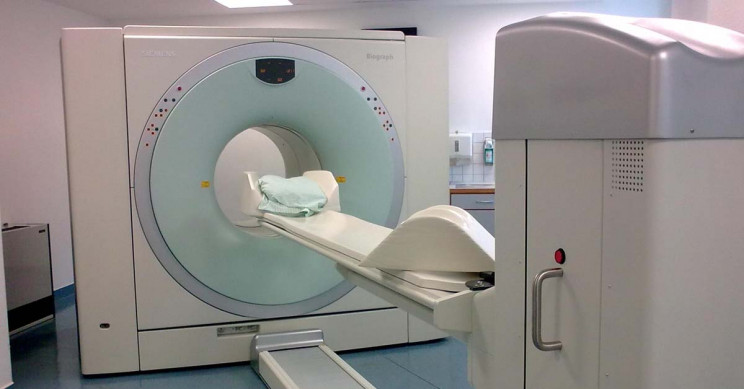
The other notable use for antimatter—as a fuel source—is a much more speculative one at the moment, but as discussed earlier, the benefits are too great to ignore.
Besides the almost total conversion from a stored fuel into usable kinetic energy for maximum efficiency possible under physics, the sheer amount of energy released by the matter-antimatter annihilation is substantially greater than even the most optimistic projections for controlled artificial nuclear fusion.
According to a paper produced by NASA in 1987, one kilogram of matter combined with one kilogram of antimatter would produce 180 petajoules of energy, or about 43 megatons of TNT, which is slightly less than the energy released by the 27,000-kilogram Tsar Bomba thermonuclear device detonated by the Soviet Union in 1961, the largest artificial explosion ever produced in human history.
Considering the incredible inefficiency of even the best chemical rocket propellants today, two kilograms of fuel for a trip into space is a lot more manageable for a trip to the Moon than the nearly 1 million gallons of liquid oxygen and kerosene fuel used by NASA’s Saturn V rocket during each of the Apollo Moon missions in the late 1960s and early 1970s.
Well, maybe manageable isn’t the right word. There’s not much risk that liquid oxygen fuel is going to spontaneously annihilate with an equal mass of the fuel tank that is containing it, but that hasn’t stopped NASA from exploring the possibility of an antimatter engine that could get humans to Jupiter and back in under a year.
Of course, it’s not all free energy and spaceships. Gamma rays are incredibly powerful, and properly converting gamma rays into usable thrust is a significant engineering obstacle—not to mention the inherent danger of astronauts riding gamma rays into space.
Gamma rays scoff at just about any kind of material barrier and can fatally ravage human tissue in nanoseconds, killing any astronauts riding such an engine into space without some serious radiation shielding. So even if we were to solve the antimatter containment problem, we’re still a long way from being able to actually use such an engine or reactor safely.
Where is antimatter found?
And now we come to what may be the biggest hurdle of them all: where exactly do you get usable antimatter?
Antiparticles are naturally produced in particle accelerators all the time, but the amount of antimatter shot out during particle collisions is a minuscule fraction of what we would need to make effective use of it. What’s more, where antiparticles go during those collisions is entirely random, so we’d have no idea where to set up an antimatter collector to capture the few particles that are produced.
And considering the expense of operating a particle accelerator and the very long waitlist of researchers who’ve booked time on it for their, producing antimatter in particle accelerators wasn’t all that economical back in 2006 when NASA was investigating a possible positron propulsion system, and unfortunately, it hasn’t gotten much cheaper in the nearly two decades since.
“A rough estimate to produce the 10 milligrams of positrons needed for a human Mars mission is about 250 million dollars using technology that is currently under development,” Gerald Smith, of Positronics Research LLC in Santa Fe, New Mexico, said at the time.
Chemical rockets are substantially cheaper today than they were in 2006, thanks in large part to SpaceX. In 2006, it cost about $10,000 for every pound of weight you carried up into space or about $4,535 per kilogram. Now, SpaceX charges about half that for its Falcon 9 rocket (about $5,995 per pound, or $2,720 per kilogram), but you are still talking about a rocket that weight three-quarters of a million pounds (about 333,000 kilograms), where most of that weight is actually the fuel needed to carry everything into orbit.
It might still be more expensive right now to try and scrape together some antimatter for fuel, but it likely won’t stay that way forever. “Based on the experience with nuclear technology,” Smith said, “it seems reasonable to expect positron production cost to go down with more research.”
On the other hand, we might not actually need to make it ourselves. Antimatter is naturally produced during cosmic ray collisions with Earth’s atmosphere, though being in the atmosphere, it likely doesn’t stick around for more than a few nanoseconds before annihilating on collision with air particles.
There is another possible source though: the Van Allen radiation belt, a ring of charged particles around the Earth that are kept in place by Earth’s magnetic field. The European Payload for Antimatter Matter Exploration and Light-nuclei Astrophysics (PAMELA) satellite found a renewable supply of antiprotons in the Van Allen belt in 2011.
Granted, it only detected 28 individual antiprotons, but in the emptiness of space, this is substantially more than anyone was expecting, and the Van Allen belt is very big. And since antiprotons carry a strong electromagnetic charge, they would be easier to collect and store using magnetic containment (which is really the only way you can store antimatter).
It might not be much to go on, but if 10 milligrams of positrons could be enough to get you to Mars and back over the course of a three-year round trip, you would need far fewer actual antiprotons in the end since they are much heavier than a positron so have much more potential energy stored in their mass.
Greatest mysteries of antimatter
The scarcity of antimatter in the observable universe is one of the biggest unsolved problems in physics even today.
During the Big Bang, the immense density and energy of the nascent universe should have produced an equal amount of matter and antimatter, which should have then been immediately annihilated to produce a universe full of energy but no matter.
This obviously did not happen, and there must have been an imbalance in the amount of matter to antimatter present during the Big Bang, or there must have been an uneven distribution of the two to produce the universe we see. It appears that the Milky Way is made up almost entirely of ordinary matter, and much of the other galaxies we can see look very much the same.
Are there antimatter galaxies out there that might not be detectable as such so that the balance that we should have seen between the two actually exists, but we just can’t see it?
That’s possible, but that doesn’t solve the problem of the uneven distribution of matter to antimatter. When matter and antimatter were created as the universe cooled in the immediate aftermath of the Big Bang, it should have produced antimatter and matter evenly throughout. If there is antimatter lurking out in the universe, unseen, that balances the scales in terms of mass, why is it all unevenly placed?
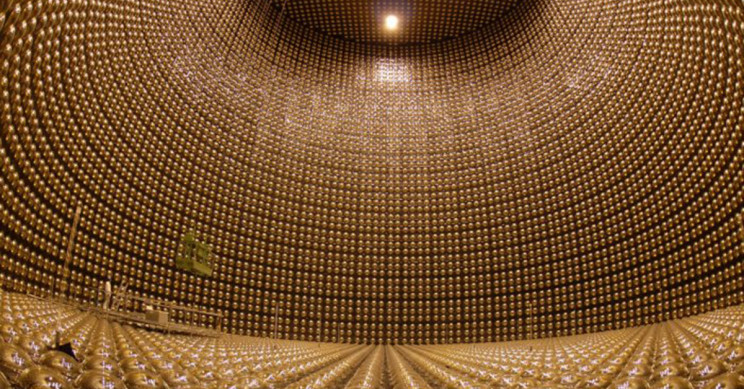
Anomalous pockets could have developed in the aftermath of the Big Bang that preferenced one kind of matter over the other, but what could have caused those pockets to develop?
This ultimately boils down to a violation of the principle of CP-symmetry (charge and parity symmetry), which says that the laws of physics should remain the same if you were to swap a particle with its antiparticle while its position in space is inverted.
That really just means that it shouldn’t have made a difference which particles were where during the Big Bang, physics is physics and there should have been an even distribution of an equal amount of both types of matter, which should have subsequently annihilated itself pretty much immediately.
The principle of CP-symmetry isn’t as ironclad as it was once believed, however. In recent decades, several observed CP violations in different kinds of decaying particles establish that the CP-symmetry principle wasn’t as sacrosanct as people believed after all.
If it can happen, it’s a good bet that it will happen, especially given the timescale and the sheer amount of mass and energy operating under the extreme conditions of the Big Bang. Are these tiny violations enough to add up to a universe absolutely dominated by ordinary matter with so little antimatter?
It’s simply not clear. Whatever the origin of this baryogenesis, as this lopsided dominance of ordinary matter is known, isn’t giving up its secrets lightly.
Maybe the James Webb Space Telescope will see something in the early universe that can give us a better sense of things shortly after the Big Bang, but there’s no way for us to ever see further back in time than about 370,000 years after the Big Bang.
It was only at that age that the universe entered the epoch of reionization, where the light of the first stars and galaxies reionized the dense, opaque fog of gas that filled the universe and turned everything transparent. Prior to that, the universe literally existed in a Dark Age that we have no hope of ever peering into, and by the time the first stars and galaxies were forming, the battle for dominance in the universe between matter and antimatter had almost certainly been settled, occurring very early on in that hazy, impenetrable past.
Antimatter vs dark matter
Though they may sound the same, antimatter and dark matter are two very different things (we think).
For starters, antimatter interacts electromagnetically with its surroundings. It’s how positrons and antiprotons can come together to form antihydrogen; it’s why annihilating particle-antiparticle pairs produce electromagnetic energy in the form of gamma rays that we can detect, and it’s why there’s even a distinction between matter and antimatter at all. A positron is essentially just an electron with its electromagnetic charge reversed, likewise with a proton, muon, etc. That’s only possible because antimatter is capable of electromagnetic interactions in the first place.
Dark matter, on the other hand, does not interact electromagnetically. As a result, we cannot detect it, hence the “dark” part, and it does not seem to respond with the same kind of electromagnetically-induced behaviors we see in normal matter.

In fact, we only know it exists because it has mass, and as such, its gravitational influence can be seen. It’s likely the reason why spiral galaxies like the Milky Way and Andromeda are stable structures, even though their mass and angular velocity should be producing enough sheer forces to rip each galaxy apart from the inside out.
Both forms of matter are elusive, though, and each comes with its own set of mysteries. Some have suggested that so-called “sterile” neutrinos and antineutrinos could be possible candidates for dark matter, but this is still fiercely debated at this time, so that is really the only (extremely tenuous) connection you might be able to make between antimatter and dark matter right now.
So what is the state of antimatter now?
As much as scientists and engineers want answers to the mysteries of antimatter, those answers seem a long way off. Likewise, our ability to fully harness the incredible power of matter-antimatter annihilations looks as distant as it did in 2006 and even earlier.
It feels like the closest we’re ever likely to get to the antimatter reactors of Star Trek is through the TV and movies that take such incredible potential for granted. That potential is as enticing as ever though, and if nothing else, the simple fact that antimatter is not only real but something we can study and learn about—and even put to productive use—is at least something to work with as we trudge our way toward the ultimate answers.



